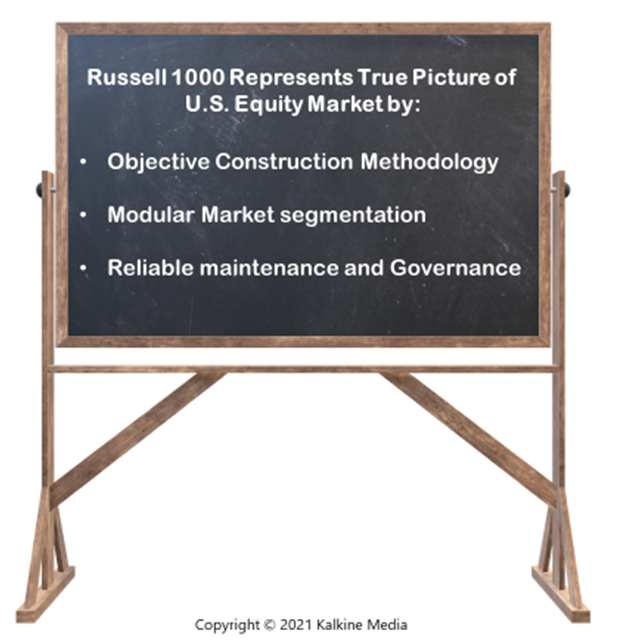What is Russell 1000?
The Russell 1000® is a US-based trading index that accommodates the stocks of the top thousand public enterprises in the country based on their market capitalization.
It was launched on January 1, 1984, and constitutes more than 90 per cent of the US market. It includes companies with lower expected growth values and lower price-to-book ratios. It is a subgroup of the Russell 3000 Index.
The Russell 1000 is considered to be an indicator for large-capitalization investment. The included companies are reviewed annually. However, the new stocks listed through initial public offerings (UPO) are added to the list on a quarterly basis.
The FTSE Russell Group, wholly owned by the London Stock Exchange Group, owns and operates the Russell 1000. The FTSE Russell is a global provider of analytics, benchmarks, and data solutions with multiple capabilities. The FTSE Russell also manages the Russell 3000 and the Russell 2000 indices.
The characteristic and performance of the Russell 1000 are shared by the FTSE Russell Group on a monthly basis. For instance, as of May 31, 2021, the Russell 1000 index has 1,019 holdings with an average market capitalization of US$ 445.558 billion and the largest stock by market capitalization of US$ 2091.965 billion.
It divides the market into segments as described by the Industry Classification Benchmark. The technology segment holds a significant share in the Russell 1000 index, followed by consumer discretionary. As of May 31, 2021, the top ten companies under Russell 1000 are:
- Apple Inc.
- Microsoft Corp.
- Amazon Com Inc.
- Facebook Inc.
- Alphabet Inc. Cl A
- Alphabet Inc. Cl C
- Berkshire Hathaway Inc.
- JPMorgan Chase & Co.
- Tesla Inc.
- Johnson & Johnson

What are the benefits of the Russell 1000 Index?
Some of the benefits of the Russell 1000 are discussed below:
- Transparent: The index is constructed using published, open, and rule-based methodology that makes it easy to understand by a financial professional. This methodology makes the index predictable and transparent.
- Market’s representative: The index is constructive to be comprehensive, objective, and modular in design with complete coverage of the underlying market without gaps and overlaps. It provides the complete picture of the top thousand enterprises by market capitalization.
- Leading methodology: The Russell 1000 and other Russell indexes have a consistent history of adapting the latest methodologies as the market evolves.
- Accurate and practical: The Russell 1000 is rigorously maintained to ensure the market segments are represented accurately. In order to represent the genuine global opportunity to the investors, the Russell 1000 index is updated with daily corporate actions, quarterly IPO inclusions, monthly share adjustments, and annual total reconstitution.
Summary
- The Russell 1000® is a US-based trading index that accommodates the stocks of the top thousand public enterprises in the country based on their market capitalization.
- It was launched on January 1, 1984.
- It constitutes more than 90 per cent of the US market.
Frequently Asked Questions (FAQs)
- Why is the Russell 1000 Index important?
The Russell 1000 Index is considered important for the investors for the reasons discussed below:
- It contains a heavy range of stocks.
- It also represents the universe of liquid and large stocks suitable for many investors' investment purposes.
- Exchange-traded funds as well as mutual funds trace the Russell 1000 Index.
- Investors seeking reliable and steady income as the Russell 1000 includes large-cap companies.
- It quickly identifies companies with large-cap, and by investing in these companies, the risk will also be moderate.
- At times, the large-cap companies are undervalued basis the technical analysis. Therefore, investors can benefit by investing in these stocks at a lower price.
- In what ways are the Standard & Poor’s 500 Index and the Russell 1000 Index similar and different?
The Standard & Poor’s 500 (S&P 500) is a weighted market capitalization of the largest 500 publicly listed companies in the United States equity market. There are other criteria also included in the S&P 500 Index. The Russell 1000 also includes large-cap publicly listed companies. However, some differences between the two are:
- The S&P 500 was established in 1923. The Russell 1000, on the other hand, is relatively a new index established in 1984.
- The composition of both indices is different as S&P 500 includes 500 large-cap companies and the Russell 1000 includes 100 large-cap companies.
- The Russell 1000 rebalances annually, and S&P does that on a quarterly basis.
Some of the similarities between the S&P 500 and Russell 1000 are:
 Please wait processing your request...
Please wait processing your request...